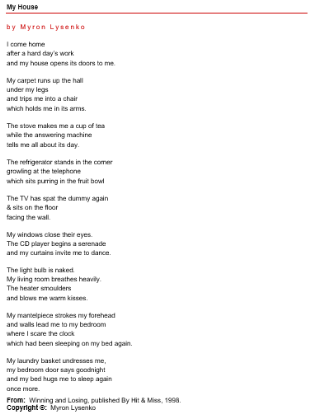“My House” is a poem by Myron Orest Lysenko (born 15 December 1952) an Australian poet of Ukrainian parentage, who mainly writes haikus.
There are different ways to use this poem in class, depending on the competences, the interests and the curriculum-goals. Here are some possible scenarios.
Different approach, more focused on creative aspect. Students start without any prior knowledge about the poem or author.
Envelope 1: Stanzas of the poem.
Envelope 2: Separate sentences of the poem.
Envelope 3: Phrases and chunks of meaning from the poem.
Envelope 4: A set of all the words the poem contains the theme or title of the poem is not given.
Objectives:
Students will enjoy reading a poem.
Students will understand the content and meaning of the poem.
Students will identify (some basic) aspects of poetry.
Students will engage creatively with poetry
Materials needed:
Copies of the poem OR envelopes with cut up versions of the poem.
Projector for displaying the poem
Worksheets for activities.
Some take-aways:
How visual elements can enhance comprehension and appreciation of literary works.
How collaboration shapes a new poem
How same source material can lead to different creative outcomes
Envelope 1: Cut up the poem into the 9 verses
Envelope 2: Cut up each sentence
Envelope 3: Cut up in phrases or chunks with meaning
Envelope 4: Cut up in words
Chat GPT has become a significant game-changer, and students are increasingly using it as a tool. However, concerns about potential misuse by students for task completion persist. Trained teachers can still easily identify the machine's writing style. To explore whether AI can genuinely replace a human writer we propose a test.
Students work in groups to compose a poem about ‘home’. Some group may only use (online) dictionaries and the internet, the opposing teams must make use of Chat GPT (free version 3.5 -many students will have a login) to create the poem.
Both teams should brainstorm ideas about content and form, deciding how to write or how to accurately formulate prompts for Chat GPT.
The poems, produced by both teams, should be submitted digitally by the lesson's end. The teacher prints and displays them in the classroom for the following class. Students then guess which were man-made and which were AI-generated, providing scores for form, content and emotional response from the reader.
Group 1: Instructions for Writing a Poem:
Mindmap ideas for a poem about "home" (personal experiences, sensory details, or abstract feelings).
List or look up literary devices to use in the poem (metaphor, simile, imagery, symbols, rhyme scheme, alliteration, sound pattern, etc.).
Collaboratively craft and type your poem.
Group 2: Instructions for Chat GPT:
Task Chat GPT with writing a poem about "home" that appears as if it were not written by AI.
Provide clear, concise instructions (called prompts) for the theme, tone, and key elements or feelings to be included.
Break down instructions into bullet points or short sentences.
Clearly state the desired mood or tone for the poem.
Include brief examples to illustrate your expectations.
If the initial response is not ideal, ask for revisions, providing specific feedback on what you liked and what should be adjusted.
Encourage creativity to make the poem convincingly man-made.
Review and clarify instructions until satisfied with the result.
These poets, though from very different eras, immigrated from their birth countries and look at the topic ‘home’ from a different perspective.
Poems by Rupi Kaur (1992- )
Perhaps we are all immigrants - and - Immigrant by Rupi Kaur
Rupi Kaur gained popularity as an Instapoet by sharing her poems on social media, where she addressed societal taboos in short poems through visual poetry illustrated by her own line-drawings. Her unique style features all lowercase letters and only periods for punctuation. She adopted this style as a tribute to her cultural roots, pointing out that Gurmukhi texts, originating from her culture, also lack capital letters.
Via the link below you can read the author’s own thoughts about growing up in 2 different worlds: she was born in Punjab, India and migrated to Canada at a young age.
(1) Rupi Kaur - being an immigrant is a funny little thing. i’ve spent... | Facebook
She continued her literary journey with "The Sun and Her Flowers" in 2017. ‘Home’ is a longer poem from this collection and makes interesting material for older students. This poem describes one particular experience of sexual assault. Rupi Kaur Kaur creates irony by mixing the imagery of sexual violence with the idea of 'home,' usually a comforting and safe place.
Poems by Kahlil Gibran (1883 – 1931)
A Lebanese-American writer, poet, and visual artist, also recognized as a philosopher. Best known for his work, "The Prophet," which was initially published in the United States in 1923, and brought him immense success. Gibran was born in a village in the Ottoman-ruled Mount Lebanon Mutasarrifate. In 1895, he migrated with his mother and siblings to the United States.
Parent’s House
It's the only house where you can go to dozens of times without an invitation.
The only house where you can put the key in the door and enter directly.
The house that has loving eyes that stare at the door until they see you.
The house which reminds you of your carefree days, stability and your happiness during your childhood.
The house in which your presence and look at your mother’s and father’s faces are for you a bliss and your conversation with them is a reward.
The house that if you do not go, the hearts of its owners will shrink.
The house in which two candles were burnt to light up the world and fill your life with happiness and joy.
The house where the dining table is pure for you and has no hypocrisy.
The house that if the food time arrives and you don't eat, the hearts of its owners will be broken and annoyed.
The house that offers you all the laughs and happiness.
Oh Children, find out the value of these houses before it's too late.
Lucky are those who have their parents' house to go to.
On Houses - from The Prophet 1923 https://poets.org/poem/houses-0









